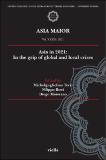Files in this item
Myanmar 2021 : repression and resistance in a multi-cornered conflict
Item metadata
| dc.contributor.author | Fumagalli, Matteo | |
| dc.date.accessioned | 2022-09-13T16:30:01Z | |
| dc.date.available | 2022-09-13T16:30:01Z | |
| dc.date.issued | 2022-09-01 | |
| dc.identifier | 281272636 | |
| dc.identifier | ea69c956-7ac9-46bc-adcd-da25fbef2ed6 | |
| dc.identifier | 85134801448 | |
| dc.identifier.citation | Fumagalli , M 2022 , ' Myanmar 2021 : repression and resistance in a multi-cornered conflict ' Asia Maior , vol. XXXII , pp. 259-276 . < https://www.asiamaior.org/the-journal/asia-maior-vol-xxxii-2021/myanmar-2021-repression-and-resistance-in-a-multi-cornered-conflict.html > | en |
| dc.identifier.issn | 2385-2526 | |
| dc.identifier.other | ORCID: /0000-0002-1451-2088/work/119212106 | |
| dc.identifier.uri | https://hdl.handle.net/10023/26003 | |
| dc.description.abstract | The parliamentary elections of November 2020 which were won – once again – in a landslide by the National League for Democracy (NLD) were followed by three months of mounting tensions between the winning party and the Tatmadaw (the armed forces) and its party affiliate. On 1 February 2021, Myanmar’s military deposed and arrested the sitting President and the State Counsellor, installing a junta which was quickly renamed the State Administration Council. This was Myanmar’s fourth coup in its post-independence history. Demonstrations and protests erupted across the country’s cities and villages in a nation-wide mass-opposition to the military intervention and its contempt for popular will as expressed in the elections. What followed was a combination of repression and resistance. An anti-coup movement initially dominated by NLD figures gradually turned into a more diverse social coalition, a more accurate expression of the country’s diversity and plural identities and interests. The military cracked down with increasing brutality. After a year of clashes, neither the Tatmadaw nor the National Unity Government had full control over either the people or the territory; neither could deliver services. A deadly stalemate emerged, with neither side willing to compromise, and with hardly any space for dialogue, each side denying the legitimacy of the other. The events of 2021 serve as stark and painful reminders that earlier characterisations of Myanmar along binaries (democracy versus authoritarianism, centre versus periphery) were misguided. This is a multi-cornered conflict. International response was split between Russia, which was supportive of the generals, China, which had good working relations with Aung San Suu Kyi and the NLD government, and a western response framed around condemnations and sanctions, which, however, were largely ineffective. | |
| dc.format.extent | 494943 | |
| dc.language.iso | eng | |
| dc.relation.ispartof | Asia Maior | en |
| dc.subject | Myanmar | en |
| dc.subject | Burma | en |
| dc.subject | Coup | en |
| dc.subject | Military | en |
| dc.subject | Repression | en |
| dc.subject | Resistance | en |
| dc.subject | Sanctions | en |
| dc.subject | Asia | en |
| dc.subject | Southeast Asia | en |
| dc.subject | Juncta | en |
| dc.subject | Protests | en |
| dc.subject | State Administration Council | en |
| dc.subject | National Unity Government | en |
| dc.subject | JQ Political institutions Asia | en |
| dc.subject | JZ International relations | en |
| dc.subject.lcc | JQ | en |
| dc.subject.lcc | JZ | en |
| dc.title | Myanmar 2021 : repression and resistance in a multi-cornered conflict | en |
| dc.type | Journal article | en |
| dc.contributor.institution | University of St Andrews. School of International Relations | en |
| dc.contributor.institution | University of St Andrews. Institute of Middle East, Central Asia and Caucasus Studies | en |
| dc.identifier.url | https://www.asiamaior.org/the-journal/asia-maior-vol-xxxii-2021/myanmar-2021-repression-and-resistance-in-a-multi-cornered-conflict.html | en |
This item appears in the following Collection(s)
Items in the St Andrews Research Repository are protected by copyright, with all rights reserved, unless otherwise indicated.

